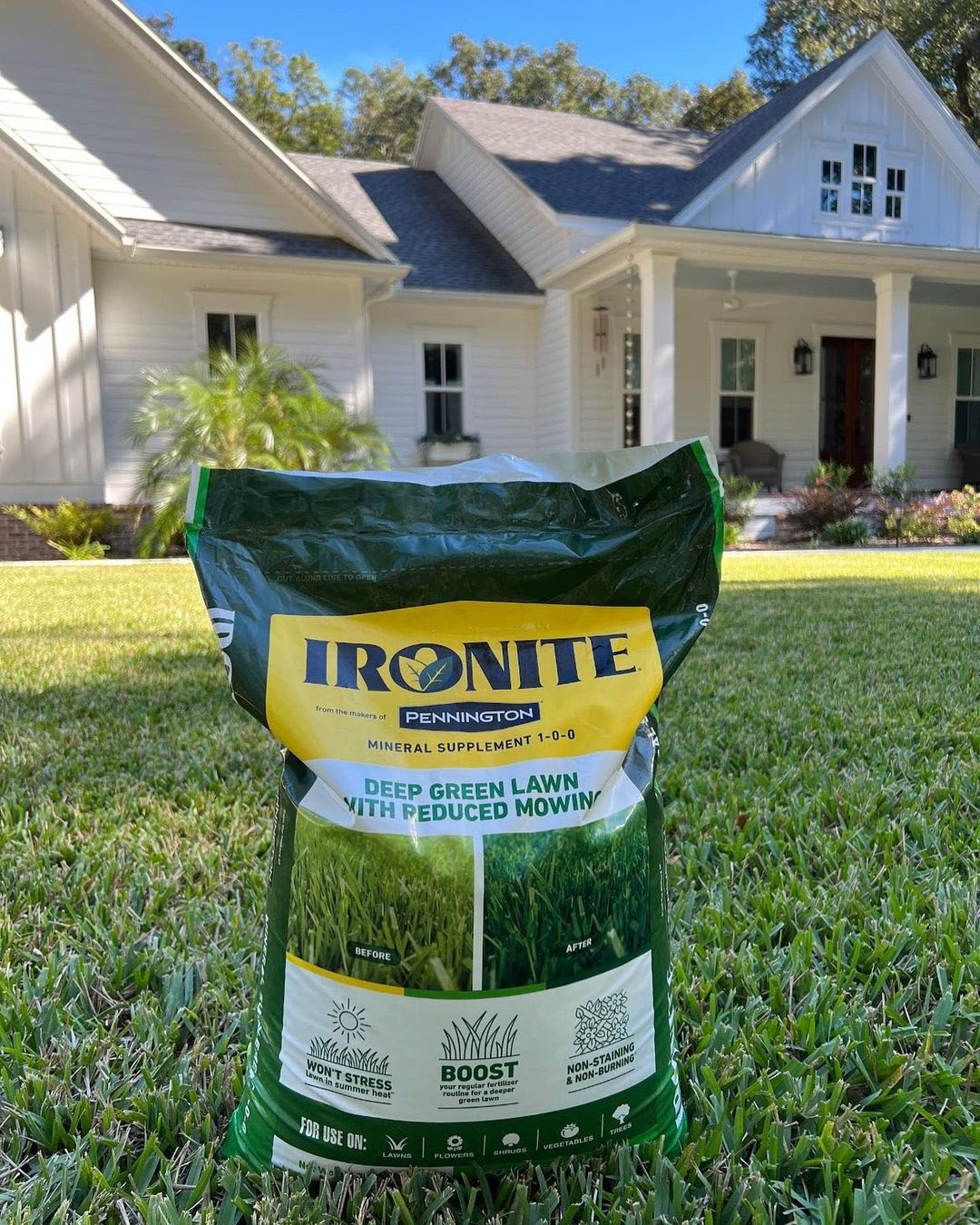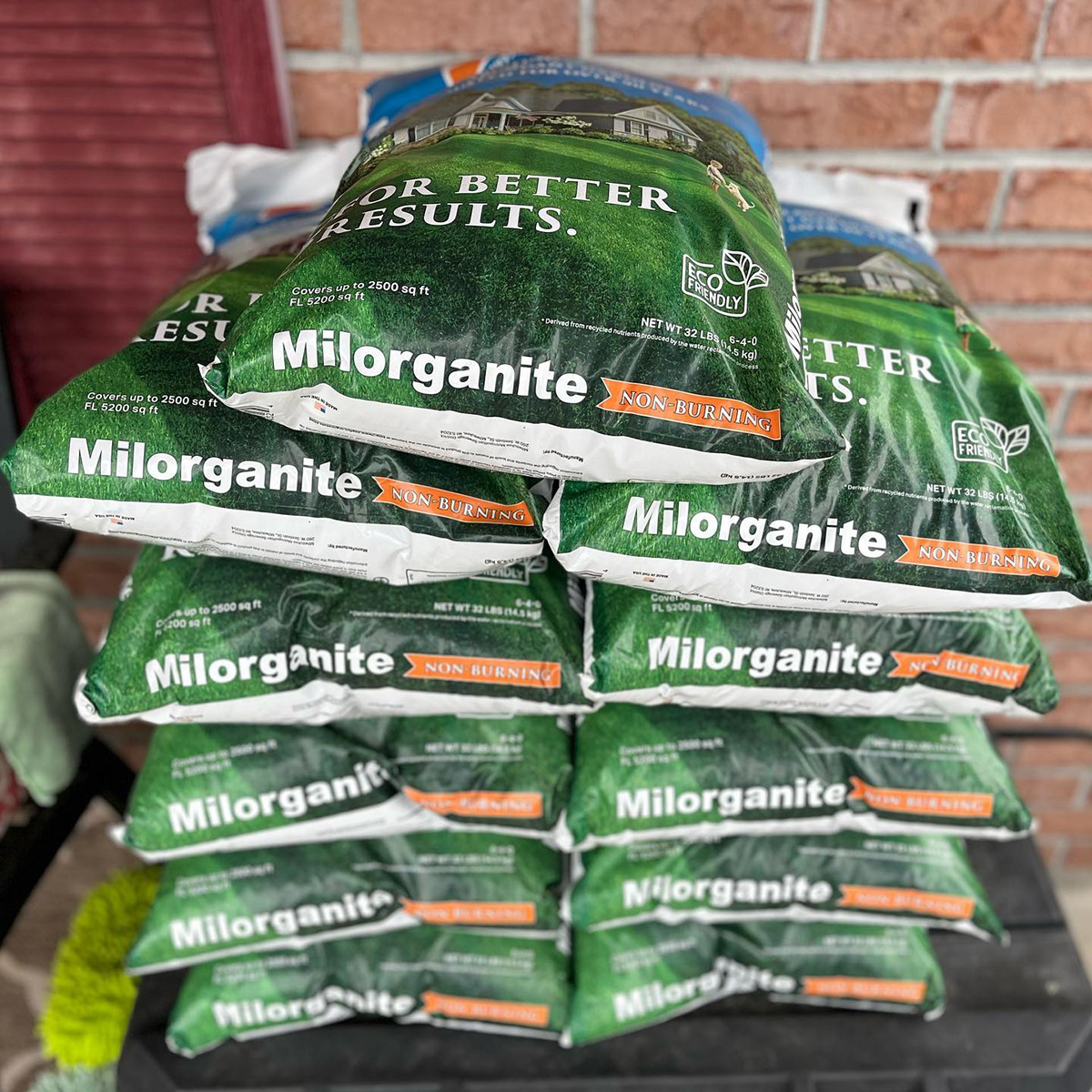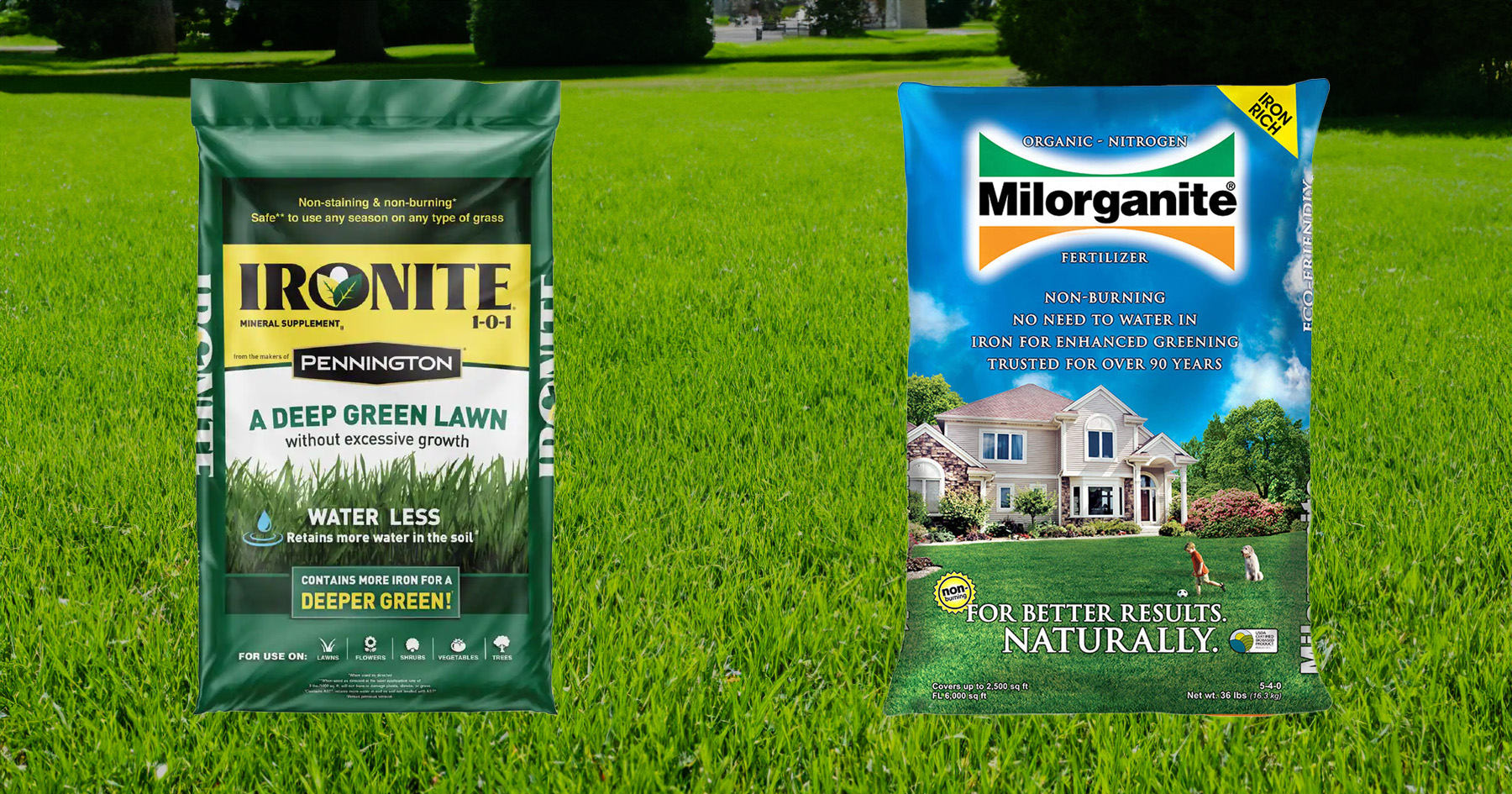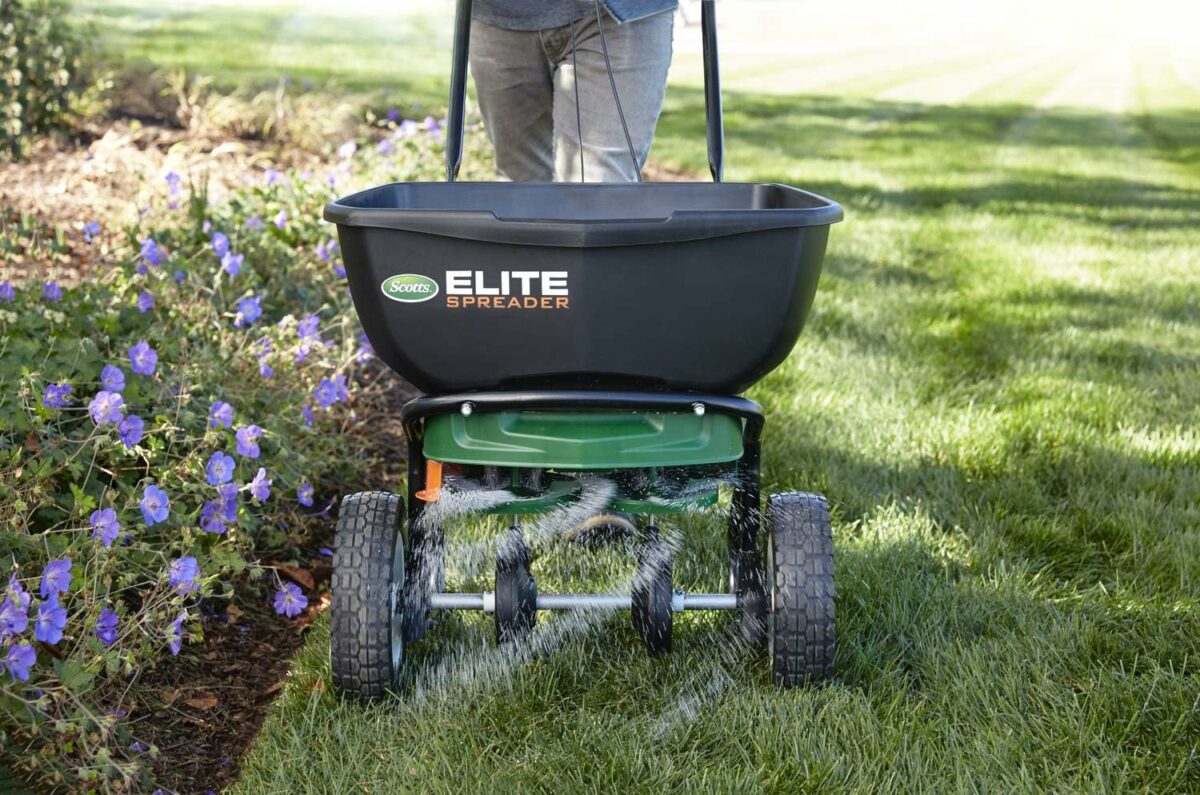Ironite vs Milorganite: Which is the ultimate solution for a lush, green lawn? It’s not just about picking a winner; both fertilizers serve different purposes.
Read on to understand their key differences and benefits. This will help you pick the best product for your yard.
- Ironite and Milorganite help improve lawn health with different nutrient compositions
- Ironite focuses on color enhancement, while Milorganite promotes growth and soil quality
- Application methods and environmental factors affect the effectiveness of both products

- Primary Purpose: Quick greening of grass with high iron content
- NPK Ratio: 1-0-1
- Iron Content: 20%
- Composition: Synthetic
- Effect on Soil Quality: Limited improvement
- Environmental Impact: Higher environmental impact
- Seasonal Efficacy: Effective in high heat for warm-season grasses
- Application Method: Granular or liquid

- Primary Purpose: Promotes overall lawn health and growth
- NPK Ratio: 6-4-0
- Iron Content: 2.5%
- Composition: Organic
- Effect on Soil Quality: Enhances soil structure and quality
- Environmental Impact: Eco-friendly and sustainable
- Seasonal Efficacy: Suitable for cool-season grasses and transitioning seasons
- Application Method: Granular or liquid
Understanding Ironite and Milorganite
Many homeowners find themselves deciding between Ironite and Milorganite lawn fertilizer. Let’s dive in and take a look at what sets them apart.
Ironite quickly greens up grass with its 20% iron and 1-0-1 NPK ratio. It offers rapid nutrients for a rich color, showing results swiftly.
Ironite provides a fast-acting source of nutrients for grass to turn green. As a quick-release mineral, results show up swiftly.
Milorganite, made from recycled microbes, is an organic fertilizer with a 6-4-0 NPK ratio and 2.5% iron. It slowly releases nutrients for faster, thicker lawn growth and is eco-friendly.
Which Should You Choose?
| Criteria | Ironite | Milorganite |
|---|---|---|
| Primary Use | Quick boost for pale grass | Long-term lawn health and growth |
| Effect | Immediate nutrient supply for lush, green appearance | Slow release of nutrients for continuous lawn nourishment |
| Environmental Impact | Higher Environmental Impact | Organic, minimizing environmental impact |
| Best For | Lawns in need of a rapid green boost | Those seeking sustained lawn health and wanting to reduce their environmental footprint |
If your grass looks pale and in need of a quick boost, Ironite is likely the better choice. It can immediately provide the necessary nutrients to help your lawn regain its lush, green appearance.
If your goal is long-term lawn health and growth, Milorganite might be a more suitable option. By slowly releasing nutrients, Milorganite ensures a continuous supply of vital elements to keep your lawn thriving. This organic fertilizer is particularly great for those who want to maintain a healthy lawn while minimizing their environmental impact.
The Nutrient Composition
Ironite Composition
 Source: ourblissfulcottage
PIN IT
Source: ourblissfulcottage
PIN IT
Ironite is known for its high iron content, making up 20% of its composition.
It comes with an NPK ratio of 1-0-1, which means that it has 1% nitrogen, 0% phosphorus, and 1% potassium.
This lawn supplement also contains other valuable micronutrients such as calcium, sulfur, boron, zinc, and copper.
These minerals contribute to your lawn’s overall health and growth, but Ironite’s main focus is providing that extra iron boost to green up your grass quickly and efficiently.
After applying Ironite, you can usually see the results within days!
Milorganite Composition
 Source: bladesofgrasslawncare
PIN IT
Source: bladesofgrasslawncare
PIN IT
Milorganite is an organic fertilizer with its own unique nutrient mix.
It has 2.5% iron and an NPK ratio of 6-4-0, which means it contains 6% nitrogen, 4% phosphorus, and 0% potassium.
In addition to iron, Milorganite also has other micronutrients like calcium, sulphur, boron, zinc, and copper. So, while this slow-release fertilizer shares some of the same nutrient characteristics as Ironite, it primarily focuses on steadily improving your lawn’s growth rate and thickness.
Here’s a comparison of the nutrient contents of the two products:
| Nutrient | Ironite | Milorganite |
|---|---|---|
| Iron | 20% | 2.5% |
| Nitrogen | 1% | 6% |
| Phosphorus | 0% | 4% |
| Potassium | 1% | 0% |
| Calcium | Yes | Yes |
| Sulphur | Yes | Yes |
| Boron | Yes | Yes |
| Zinc | Yes | Yes |
| Copper | Yes | Yes |
Both Ironite and Milorganite provide essential nutrients for your lawn, but they have different primary focuses.
Ironite works quickly to re-green your grass by supplying a higher amount of iron, while Milorganite is designed to slowly release nutrients for a steady and long-lasting lawn improvement.
Modes of Application
Both of these lawn supplements come in different forms, including granular and liquid.
Granular Ironite and Milorganite
Applying granular products is quite popular because it’s simple and effective. Just grab a broadcast spreader or a drop spreader and follow the guidelines on the product label for application rates.
Make sure to walk at a consistent pace and apply evenly across your lawn.
Pro tip: If you’re using a broadcast spreader, set it to a low setting to avoid overlapping and over-application.
Liquid Ironite
Liquid Ironite is a great option, especially if you’re looking for an even faster result than granular applications.
To apply liquid Ironite, you’ll need a hose-end sprayer or a backpack sprayer.
Dilute the product according to the instructions and then spray it evenly over your lawn. The best part? You’ll see the results within just a few days!
Note: Don’t forget to water your lawn after applying granular or liquid products. This will help the nutrients penetrate the soil and reach your grass’s roots.
Granular vs. Liquid – Pros and Cons
Here are some quick pros and cons to help you decide which mode of application is right for you:
- Granular:
- Pros: Easier to store and handle, longer shelf life, and typically requires fewer applications
- Cons: Slower to show results and needs proper application to avoid burns or uneven distribution
- Liquid:
- Pros: Faster results, easier to apply evenly, and can be mixed with other liquid lawn care products
- Cons: Shorter shelf life, more frequent applications, and requires extra care when mixing the product
Effect on Soil Quality
When it comes to improving soil quality, Milorganite takes the lead.
It’s an organic fertilizer that not only nourishes your lawn but also enhances the quality of the soil itself. The magic lies in its slow-release nutrients, which steadily supply essential elements to the soil. These nutrients help improve soil structure, promoting better water infiltration and retention.
Ironite is known for its quick-release minerals that turn your grass greener. It’s specifically designed to reverse the yellowing of grass due to iron deficiency, making your lawn lush and vibrant.
With 20% iron content, Ironite addresses the issue of iron deficiency quickly. But as it mainly focuses on iron supplementation, its contributions to overall soil health improvement are not as prominent as Milorganite’s.
Both Milorganite and Ironite can be beneficial in specific soil conditions.
If you have alkaline soil or clay soil, Ironite is a good choice! The iron content in Ironite helps counter the high pH levels in alkaline soil, allowing plants to absorb nutrients more effectively.
Milorganite can work wonders in clay soil, thanks to its ability to improve soil structure, allowing for better aeration and drainage.
Safety and Environmental Concerns
Safe for Kids and Pets: Both Milorganite and Ironite are generally safe for your kids and pets. However, it’s always a good idea to keep your little ones and furry friends off the lawn for a few hours after application, just to be on the safe side.
Burn risk: Both products have a very low risk of burning your lawn. Although, it’s still important to follow the recommended application rates.
Arsenic: Here’s where some people have concerns, this is due to the fact that Ironite has been found to contain low levels of arsenic in the past. But the formula for Ironite has since been changed and it is now approved for use on food crops.
Environment and Sustainability: Milorganite takes the lead here, as it’s made from recycled biosolids, making it an eco-friendly and sustainable option. Ironite mining is more energy-intensive and has a higher environmental impact. That being said, it’s still a viable option for those seeking fast-acting results.
Staining concrete: Unfortunately, Ironite can stain concrete surfaces due its high iron content. So, it’s best to exercise caution when applying it near sidewalks, driveways, or other concrete surfaces.
Efficacy in Different Seasons
Spring and Summer
Summer is a popular time for warm-season grasses, and they flourish in high heat. With Ironite’s higher iron content (20%) compared to Milorganite’s 2.5%, your warm-season grass receives the crucial nutrients necessary for it to maintain its vibrant green color without promoting excessive growth.
So, when the temperatures rise, Ironite is a solid choice to keep your summer lawn looking stunning.
Fall and Winter
On the other hand, cool-season grasses can suffer in intense summer heat. In this case, Milorganite’s balanced NPK ratio of 6-4-0 aids in recovery and sustains the overall health of cool-season grass varieties. It will give the grass a much-needed growth boost during high-stress situations, allowing it to recover and reestablish rapidly.
As the seasons change and temperatures become milder, Milorganite shines for cool-season grasses. The slow-release, organic nature of Milorganite supports steady, healthy growth, allowing the grass to become thicker, fuller, and achieve a deep green color. The added iron (2.5%) is like the cherry on top for enhancing the overall visual satisfaction of your lawn.
What Customers Say
Below are some comments from customers that have had experience with Ironite and Milorganite.
Frequently Asked Questions
What are the main differences between Ironite and Milorganite?
Ironite and Milorganite have different purposes and compositions. Ironite is primarily an iron supplement and helps your lawn turn green without excessive growth, while Milorganite supports thick and full growth while turning your lawn into a deep green color. This difference is because of the NPK (Nitrogen, Phosphorus, and Potassium) and iron ratios in their formulations.
When is the best time to apply Ironite?
The best time to apply Ironite depends on your lawn’s condition and appearance. If your grass is turning yellow or showing signs of iron deficiency, you can use Ironite regardless of the season. However, avoid applying it during extremely hot or dry periods. The ideal time would be during the growing seasons for your type of grass.
Is liquid or granular Ironite more effective?
Is liquid or granular Ironite more effective?
Both liquid and granular Ironite have their own advantages. Liquid Ironite offers quick absorption and fast results, making it suitable for treating specific areas with iron deficiency. Granular Ironite is slow-release and provides a more even distribution, which is helpful for improving the overall health of your lawn. Choose the one that aligns with your specific needs and desired outcomes.
What are the iron contents of Ironite and Milorganite?
Ironite and Milorganite each contain significant amounts of iron, with Ironite containing nearly 20% iron and Milorganite containing roughly 4% iron in their respective formulations. Ironite has a higher concentration, which makes it a suitable choice to supplement the iron content in your lawn.
Can Milorganite make my grass darker green?
Yes, Milorganite can make your grass darker green. Thanks to its slow-release nitrogen and iron content, Milorganite aids in turning your lawn into a deep green color while promoting thick and full growth. A healthy, well-fed lawn with an adequate iron supply often displays a rich, deep green color.
Should I use chelated iron instead of Ironite?
Using chelated iron instead of Ironite depends on the specific needs and conditions of your lawn. Chelated iron is often used for its quick absorption and faster correction of iron deficiencies. If your lawn needs an immediate boost of iron, or you are dealing with specific problem areas, opting for chelated iron might be a better choice. Ironite, on the other hand, is more suitable for a gradual improvement in the overall health and appearance of your lawn.
What are the iron contents of Ironite and Milorganite?
Ironite and Milorganite each contain significant amounts of iron, with Ironite containing nearly 20% iron and Milorganite containing roughly 4% iron in their respective formulations. Ironite has a higher concentration, which makes it a suitable choice to supplement the iron content in your lawn.
Can Milorganite make my grass darker green?
Yes, Milorganite can make your grass darker green. Thanks to its slow-release nitrogen and iron content, Milorganite aids in turning your lawn into a deep green color while promoting thick and full growth. A healthy, well-fed lawn with an adequate iron supply often displays a rich, deep green color.
Should I use chelated iron instead of Ironite?
Using chelated iron instead of Ironite depends on the specific needs and conditions of your lawn. Chelated iron is often used for its quick absorption and faster correction of iron deficiencies. If your lawn needs an immediate boost of iron, or you are dealing with specific problem areas, opting for chelated iron might be a better choice. Ironite, on the other hand, is more suitable for a gradual improvement in the overall health and appearance of your lawn.

